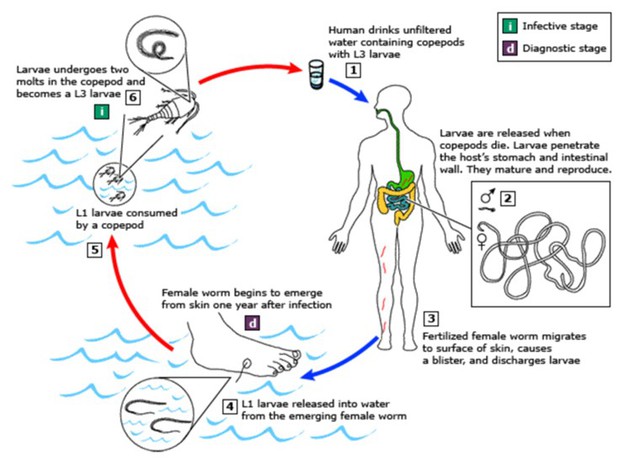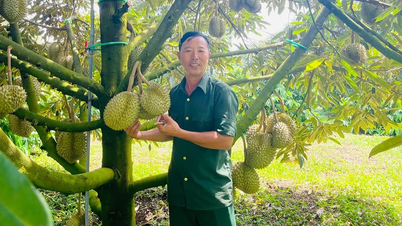Master - Specialist Doctor 1 Huynh Vo Quoc Kha, Allergy - Immunology Clinic, University of Medicine and Pharmacy Hospital, Ho Chi Minh City - Facility 3, said that cases of dragon worm infection are mainly in underdeveloped countries with poor sanitation conditions, especially in Africa, South Sudan, Ethiopia and Mali; usually people who make a living by farming.
The disease can occur at any age, but usually occurs in adults from 15 to 45 years old, regardless of gender. However, Vietnam has recently recorded more than 20 cases in the past 5 years (from 2020 to early 2025), mostly in the northern mountainous provinces such as Yen Bai, Phu Tho, Thanh Hoa, Hoa Binh . Most patients are men, with a history of eating raw or undercooked aquatic foods.
Dragon worm infection cycle
Image of the dragon worm infection cycle. Photo: BVCC
(1) People become infected when they drink unsanitary water containing copepods - small crustaceans that carry the larvae of Dracunculus medinensis.
(2) After being ingested, the crustacean dies and releases larvae, which penetrate the stomach and intestinal walls and enter the abdominal cavity and retroperitoneal space.
(3) After maturity and mating, the male worms die, and the female worms (70-120 cm long) will move in the subcutaneous tissue towards the skin surface.
(4) About 1 year after infection, the female worm causes blisters on the skin, usually on the lower limbs far from the body, which then rupture. When this lesion comes into contact with water, the female worm exits the skin and releases larvae into the water (4).
(5) The crustaceans eat these larvae, and after two weeks and two molts, they develop into infective stage larvae (6).
When the larvae enter the body, they penetrate the stomach lining and intestinal wall, migrate into the connective tissue, and develop into adult worms. Male worms die after mating. Female worms mature after 9-14 months, can be up to 1 meter long, and migrate under the skin.
The early stages of the disease are often asymptomatic. About a year after infection, the female worms migrate to cooler skin surfaces and begin to emerge, usually into the feet.
At the site of the worm's exit, blisters, ulcers, swelling, itching and pain may appear. The patient often soaks his feet in water to relieve the pain, causing the worm to crawl out of the blisters and release the first stage larvae into the water. Several worms may exit at the same time. The process lasts up to 8 weeks or longer. Systemic symptoms may include: fever, rash, nausea, vomiting, diarrhea.
Dragon worms are rarely fatal.
According to specialist 1 Huynh Vo Quoc Kha, dragon worms rarely cause death. Severe complications are usually due to secondary bacterial infections or sepsis. Abscesses can occur when worms migrate to other organs such as the lungs, pericardium, and spinal cord. When worms pass through joints, they can cause joint pain and muscle cramps. In some cases, if worms die before exiting, they can calcify, causing pain. If worms are broken while exiting, they can cause severe inflammation, edema, sepsis, or cellulitis.
Diagnosis is mainly based on the characteristic clinical symptom of worms emerging from ulcers. Blood tests may show eosinophilia. If worms die and become calcified, they can be detected on X-ray. Differential diagnosis is with filariasis or cellulitis.
Treatment is mainly slow removal of worms combined with wound care and pain control. Symptomatic treatment with pain relievers, anti-inflammatory drugs; antihistamines to reduce itching, topical antibiotics to prevent secondary infection or systemic antibiotics in case of cellulitis, sepsis or abscess.
Prevention is the only effective way to combat this disease. The main thing is to eat well-cooked food, drink boiled water, and avoid eating raw, unprocessed foods, especially aquatic species. Patients must also avoid contact with drinking water sources to avoid spreading the disease.
Source: https://thanhnien.vn/nhiem-giun-rong-do-dau-nguy-hiem-khong-185250601002405046.htm

































































































Comment (0)